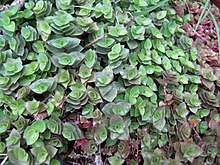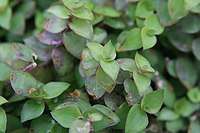Callisia repens
Callisia repens, also known as creeping inchplant, Bolivian Jew or turtle vine, is a succulent creeping plant from the family Commelinaceae. This species comes from Central and South America.[1]
| Callisia repens | |
|---|---|
 | |
| Scientific classification | |
| Kingdom: | Plantae |
| Clade: | Tracheophytes |
| Clade: | Angiosperms |
| Clade: | Monocots |
| Clade: | Commelinids |
| Order: | Commelinales |
| Family: | Commelinaceae |
| Genus: | Callisia |
| Species: | C. repens |
| Binomial name | |
| Callisia repens (Jacq., 1762) | |
| Synonyms | |
Description

The perennial plant forms creeping mats. The flowering shoots are ascending. The fleshy, delicated leaves grow smaller towards the tip of the shoot. The leaf blade is oval to lanceolate, one to 3.5 centimeters long and 0.6 to one centimeter wide. In the distal leaves, the blades are narrower than the open, spread leaf sheaths. It grows quickly, multiplies easily by long, creeping shoots that root in each node, as soon as it is on the ground.
The inflorescences sit in the armpits of the distal leaves of the flower sprout and consist of paired cymes. Produced in the summer, the flowers are hermaphrodite and odorless. The bracts are inconspicuous, white, lanceolate and three to six millimeters long. There are zero to six stamens with smooth filaments. The ovary is bipartite and has a brush-like scar. Capsule fruits with one millimeter large seeds develop.[2]
Distribution
The species is native to America from the southeast of the United States (Texas, Florida) via the West Indies (Guadeloupe and Martinique) to Argentina and grows in shady, rocky or gravelly spots in subtropical to tropical forests. It is naturalized in Hong Kong and grows on rooftops. In Western Australia, it is an invasive species due to its rapid growth, its tolerance to various environments and the ground cover effect which make it spread very quickly, suffocating local plants or preventing them from germinating.[3]
Cultivation
The species is occasionally used as a pot and traffic light plant as an ornamental plant and it is easily propagated by cuttings. It is also marketed as a houseplant for its drooping habit and the scent of its white flowers. Strong light makes the foliage blush, but the plant cannot stand direct sunlight. The optimum growth conditions is between 18–22 °C during the day and at least 12°C at night. Pests include snails.
References
- Tropicos.
- Callisia repens (creeping inch-plant) Invasive Species Compendium (CABI). 22 February, 2020
- Home gardeners urged to look out for pest plant By the Department of Primary Industries and Regional Development (Government of Western Australia), 15 January 2019